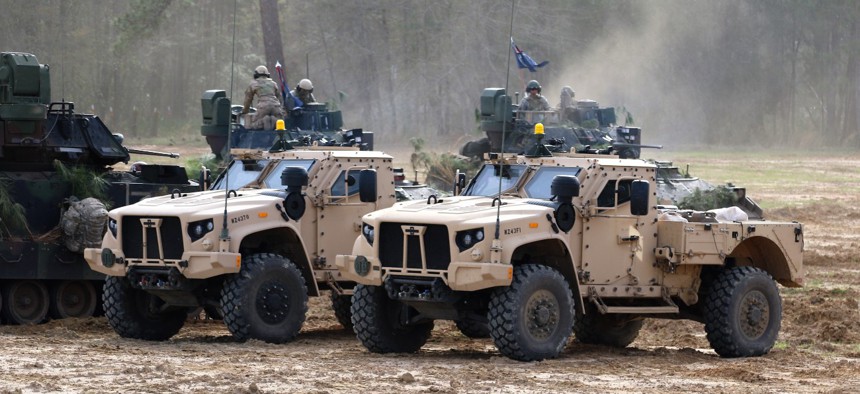
Two JLTVs during an exercise at Fort Stewart, Georgia. Staff Sgt. Quanesha Barnett
Here’s What Might Not Survive COVID Budget Cuts
Like baby antelope at the watering hole, military weapons and vehicles still in early development might be the first to go.
With global military spending expected to flatten or contract in the coming years as countries try to repair coronavirus-decimated economies, defense projects already on the books stand the best chance of survival, according to a budget expert.
That could spell delays, deferrals or cancellations for weapon projects still in early development, including new Air Force fighter jets, Army helicopters and Navy ships.
“Things that tend to already be in production, or already have contracts awarded and source selection completed, those tend to have more staying power, just because of the built-in congressional support for them,” said Todd Harrison, director of defense budget analysis at the Center for Strategic and International Studies. “Programs that are still very early and development tend to have less of that support.”
Projects still under development with a key role in the National Defense Strategy that guides U.S. defense spending — and which isn’t expected to change much whether President Donald Trump is elected to a second term or if he is beaten by Democrat nominee former Vice President Joe Biden — stand a better chance of survival. That plan directs the United States to prepare for great power competition between the United States and Russia and China in the years to come.
One Army project at risk of being delayed or canceled is the Future Attack Reconnaissance Aircraft, a light helicopter that would replace the OH-58 Kiowa, Harrison said.
“I kind of have to scratch my head and say: ‘Really, how does this fit into the NDS? How does this fit into great power competition?’” Harrison said. He questioned why the Army wouldn’t use existing Gray Eagle or Reaper drones for the same kinds of armed reconnaissance missions, particularly in areas of lightly defended airspace. Neither the new helicopter or those drones would be able to fly in airspace defended by fighter jets and surface-to-air missiles, as would be expected with major countries like China or Russia.
Budget cuts could also lead the Army to buying fewer Joint Light Tactical Vehicles, remanufactured Abrams tanks, and other ground vehicles.
“But honestly, the Army doesn't have a lot of money invested in acquisition programs to begin with … it's only about 21 percent of the Army's budget,” Harrison said. “Overall, I think if the Army's forced to make cuts, it's going to have to cut force structure.”
Air Force projects at risk include the Next Generation Air Dominance, or NGAD, a new series of fighter jets.
“Is that really going to produce a short-range fighter that's going to be really relevant against Russia and China in the foreseeable future?” Harrison said.
The new fighter jets would compete for funding against the F-35 Joint Strike Fighter and its strong backing in Congress.
NGAD "doesn't have a built-in constituency yet,” Harrison said. “It is competing directly for funds with things like the F-35 that do have a built-in constituency. And it's not well defined enough yet to defend it.”
As for the Navy, it will continue to have difficulty trying to build a 355-ship fleet and buy new nuclear ballistic missile submarines, according to Seamus Daniels, a research associate and program manager for defense budget analysis at CSIS.
“We know that representatives from shipbuilding districts with the shipyards [are] a very strong constituency,” he said. "I think the bigger question ... in terms of the ship programs, is whether they're going to adjust the ship count method so then they will actually be able to get closer to 355.”







